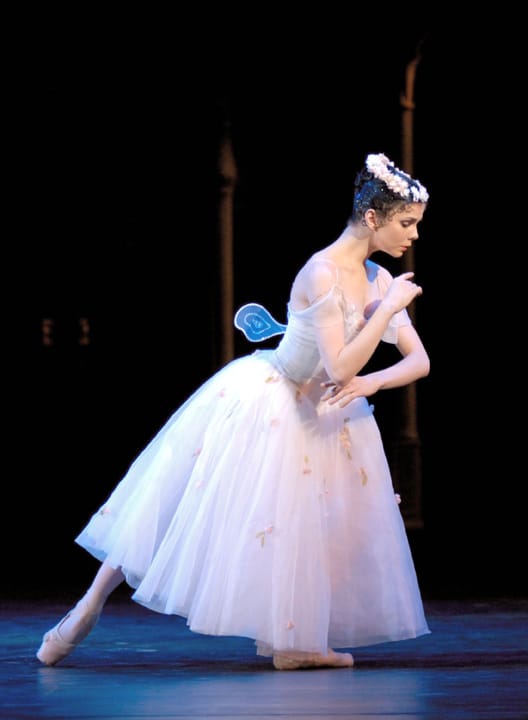Dancing on Air

"Airs", "La Sylphide"
American Ballet Theatre
Metropolitan Opera House
New York, NY
June 17, 2009
The imaginative pairing of Paul Taylor's celestial "Airs" and August Bournonville's magical "La Sylphide" makes for a very satisfying evening. Of course, it is a lot to ask of a company to look completely comfortable in two different and distinctive styles, and no one would take ABT for either Paul Taylor dancers or Danes. "Airs", though, had a serene and forthright glory, led by Simone Messmer as the odd girl out. It was cast from corps and soloist ranks, including many who had made such an impression in the fall season's Taylor success "Company B". Among these were Joseph Phillips, who danced the playful and flirty pas de deux with Kelley Boyd like an all-American faun. Roddy Doble (who had been so exuberant in "Company B") coped well, though not quite effortlessly, with the difficult partnering. Messmer, who had been such a magnificent Myrtha is last week's Giselleathon, combined weight with a glorious sense of movement, seeming to carve through the air, and create a separate space for herself; there is loneliness, even in Taylor's paradise.
James, the hero of "La Sylphide" is, at heart, lonely too, even with a loving mother, a beautiful fiancee, and lots of energetic friends. ABT's version was set by the original Great Dane Eric Bruhn, and is a respectable, though not perfect, version of the ur-Romantic ballet, where a man meets a magical, desirable, but ultimately unattainable creature. James was Herman Cornejo, whose dancing was fleet and fine, but who didn't really have the uneasy, melancholy yearning of a true James. The Sylph was the Russian dancer Natalia Osipova, who, as a new member of the corps when the Bolshoi visited a few years ago, gave the impression that she had appeared at her ballet school with a sign reading "Hello, My Name is Kitri"; a glimpse of her as the "fifth shepard girl from the right" was enough to see that she was principal material.
However, she is still very young, and though prodigiously gifted (she basically reinvents ballon), with a genuine charm, her Sylph was sketched. Her arms, understandably given her Russian training, had little of the Romantic charm, and she let them float as if she were an underwater creature. The mime too, was a bit vague (though this may be due to the production); she is supposed to tell James that she had seen him out hunting and the she had been watching him grow up from childhood, making it clear that she is not part of his time. And her poor final gestures, when she gives him back the ring that she had stolen, should tell him that he should return to Effie before it is too late, basically accepting responsibility for enticing him away.
The character of James, too, is more complicated than this performance showed. Why does he leave his perfectly acceptable life to chase the Sylph--is he a dreamer, an idealist, a man out of his time? And why is he so rude to Madge, the witch? (One explanation is that she knows too much about him, and that he is afraid.) Without this complexity, he just seems ill-mannered.
And the current version which had Gurn, the man who loves Effie, and James dance joyfully at the betrothal, which while it gives them something to do, does interfere with the drama. Gurn is furious because he thinks James is hiding something (which he is), and because he wants Effie for himself, and James is (or should be) lost in his own world thinking about the Sylph--neither would be jumping for joy. (Bournonville, a great man of the theater, gave the two solos to corps members.) Gurn, too, has turned into something of a comic; I remember seeing a Danish production where the dancer made it clear that when Madge told him to lie about finding James' coat, this fundamentally decent man came to a moral crisis and completely failed--it was one of the most wrenching 3 seconds of drama I have seen. Theatrically, I think it is a mistake to have the girls in the betrothal party wear pastels, since there isn't enough contrast between them and the second act sylphs. They should be hearty farm girls, not peasants, but not girls who traveled to and from Bath and suffered from the vapors, so that the vision in white of the second act comes as an unexpected thrill.
Victor Barbee was Madge, the witch who destroys James, or rather the agent which lets James feel he has a choice. This role is traditionally danced by both men and women, and Barbee used his masculine power very well, and his height let him tower over the proceedings. He was more of a quirky old lady in the opening scenes, rather than an overpowering malignant force, though this changed by the final scene, where his/her triumph was shattering.
copyright © 2009 by Mary Cargill



